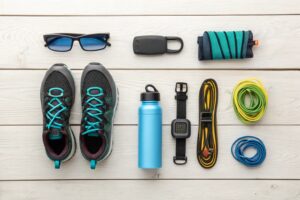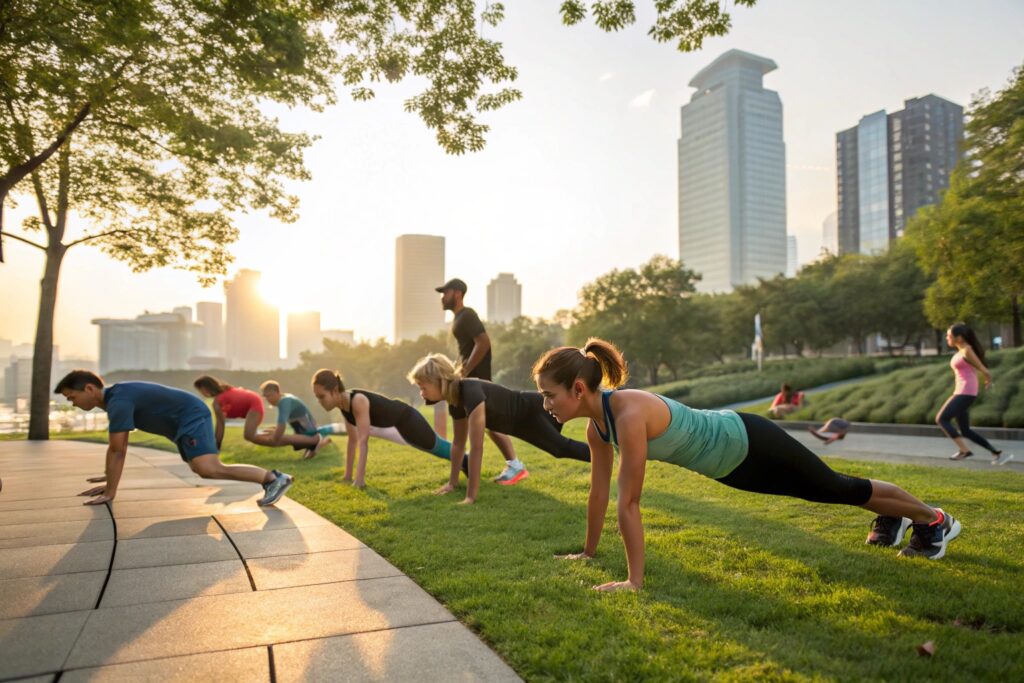The world is witnessing The Growing Popularity of Outdoor Workouts: How to Take Your Fitness Routine Outside as people trade four‑walls gyms for fresh air, sunshine, and limitless space. From city parks to mountain trails, exercising outdoors offers mental clarity, stronger immune function, and a deeper connection to nature—all while burning calories more efficiently. This shift isn’t a fleeting trend; it’s a lifestyle evolution that reshapes how we think about health and community.
Why are more people opting for outdoor training? The answer lies in a convergence of science, technology, and cultural change. Modern research confirms that sunlight triggers vitamin D synthesis, which aids muscle function and mood regulation. Meanwhile, wearable tech lets enthusiasts track heart‑rate zones, distance, and elevation without stepping inside a club. Add the rising desire for social‑distanced activities post‑pandemic, and you have a perfect storm that fuels the momentum behind outdoor fitness.
In the sections that follow, we’ll dive deep into the benefits, the best environments for training, essential gear, safety strategies, and a step‑by‑step plan to migrate any indoor routine to the great outdoors. Whether you’re a seasoned athlete seeking new challenges or a beginner craving motivation, these insights will empower you to thrive outside.
Why Outdoor Workouts Outperform Indoor Gyms (Great keyword)
1. Natural Light Boosts Hormonal Balance
Exposure to natural light stimulates the pineal gland to regulate melatonin, which improves sleep quality and recovery. Studies from the Journal of Sports Science show a 15‑20% increase in testosterone levels after consistent morning runs in daylight, directly translating to stronger muscles and faster fat loss compared to artificial lighting environments.

2. Terrain Variability Increases Functional Strength
Uneven surfaces such as grass, gravel, or forest trails force stabilizer muscles to engage continuously. This “proprioceptive training” enhances balance, coordination, and joint stability, reducing the risk of injuries that are common in the repetitive, linear motions of treadmill or treadmill‑only workouts.
3. Mental Health Benefits Are Proven
A 2022 meta‑analysis of 30 peer‑reviewed studies found that outdoor exercise lowers cortisol by up to 30% and lifts serotonin levels more significantly than indoor sessions. The combination of fresh air, natural scenery, and rhythmic movement triggers the “green exercise” effect, which mitigates anxiety, depression, and burnout.
Top Outdoor Settings for Every Fitness Goal (Great keyword)

Urban Parks – The Convenient Powerhouse
City parks provide paved loops, open fields, and often have free fitness stations. They’re perfect for high‑intensity interval training (HIIT), bodyweight circuits, and group boot‑camps. Look for parks with water fountains and shaded benches to stay hydrated and recover between sets.
Beachfronts – Natural Resistance Training
Running on sand creates a natural resistance that forces calves, glutes, and core muscles to work harder. A 5‑km beach run can burn up to 30% more calories than the same distance on asphalt, and the shoreline provides ample space for plyometric drills and sandbag lifts.
Mountain Trails – Elevation for Cardio Mastery
If you crave a cardiovascular challenge, hit a hill or mountain trail. The altitude reduces oxygen availability, prompting the body to produce more red blood cells—a process known as erythropoiesis. This adaptation improves aerobic capacity for future indoor or outdoor races.
Backyard & Home Gardens – Private, Controlled Environments
A well‑maintained yard can become a personal training zone. Install a pull‑up bar, yoga mat, and a set of adjustable dumbbells to replicate a mini‑studio. The advantage is zero commute, unlimited privacy, and the ability to schedule workouts whenever weather permits.
Essential Gear to Make Outdoor Workouts Safe and Effective (Great keyword)

Footwear Tailored to Terrain
Invest in trail‑running shoes with aggressive outsoles for rocky paths, or minimalist shoes for beach sand. The right shoe reduces impact forces, enhances grip, and prevents common injuries like plantar fasciitis.
Weather‑Resistant Clothing
Layering is key. Use moisture‑wicking base layers, an insulating mid‑layer for cooler mornings, and a breathable, waterproof outer shell for rain. Reflective elements boost visibility during low‑light conditions, keeping you safe while you jog at dawn.
Portable Technology
A waterproof fitness watch or a chest‑strap heart‑rate monitor syncs to your smartphone, providing real‑time data on intensity zones, GPS distance, and elevation gain. Pair this with a lightweight, foldable foam roller to aid post‑workout muscle recovery on the go.
Hydration & Nutrition Packs
For workouts exceeding 60 minutes, carry a hydration bladder (1–2 L) or a reusable water bottle with an insulated sleeve. Add electrolyte tablets for hot climates and a small stash of quick‑energy snacks—think dates, nuts, or energy gels—to maintain blood sugar levels.
Safety Protocols and Best Practices for Outdoor Training (Great keyword)
Know Your Environment
Scout the area before the first session. Identify potential hazards—uneven pavement, low‑hanging branches, or traffic crossings. Use apps like Strava or AllTrails to download offline maps, enabling navigation without draining your phone battery.
Stay Visible and Heard
Wear high‑visibility clothing and a lightweight whistle or a personal safety alarm. If you train in isolated locations, share your route with a trusted friend or family member and set an estimated finish time.
Sun Protection Is Non‑Negotiable
Apply broad‑spectrum SPF 30+ sunscreen 15 minutes before heading out and reapply every two hours. Wearing a UV‑blocking hat and sunglasses reduces the risk of sunburn, premature skin aging, and heat‑related fatigue.
Adapt to Weather Conditions
On hot days, schedule workouts for early morning or late evening to avoid peak UV intensity. In colder climates, perform a dynamic warm‑up for at least 10 minutes to raise core temperature and prevent muscle strains.
Post‑Workout Recovery in the Outdoors
Take advantage of the natural environment for active recovery: walk briskly, perform gentle yoga stretches on a park bench, or use a portable foam roller under a shaded tree. The fresh air accelerates circulation and reduces muscle soreness.
Step‑by‑Step Guide: Transitioning Your Indoor Routine Outside (Great keyword)
Step 1 – Assess Your Current Program
List the exercises you perform indoors (e.g., treadmill, bench press, cycling). Categorize them by equipment, intensity, and muscle groups. This inventory helps you map equivalents that can be done outdoors without losing training fidelity.
Step 2 – Match Outdoor Substitutes
Replace treadmill runs with trail runs, stationary bike intervals with hill sprints, and cable machine rows with resistance‑band rows anchored to a sturdy tree. For strength work, use bodyweight variations (push‑ups, pistol squats) or portable equipment like sandbags and kettlebells.
Step 3 – Design a Weekly Outdoor Schedule
Aim for 3–5 sessions per week, balancing cardio, strength, and mobility. Example:
-
- Monday: 45‑minute trail run + 10‑minute mobility circuit
-
- Wednesday: Beach HIIT (30 s sprint / 30 s walk) + sandbag circuit
-
- Friday: Park boot‑camp: pull‑ups, box jumps, farmer’s walk
-
- Saturday (optional): Yoga in the grass and a light recovery jog
Step 4 – Track Progress & Adjust
Use a fitness watch to record distance, elevation, and heart‑rate zones. Review weekly metrics to ensure you’re hitting target intensity zones (e.g., 70‑85% of max HR for cardio). If a particular outdoor activity feels too easy, increase distance, add load, or incorporate interval structures.
Step 5 – Keep the Motivation High
Join local outdoor fitness groups on platforms like Meetup or Facebook. Participate in community challenges—5 K park runs, beach boot‑camps, or sunrise yoga series. Social accountability, combined with the natural endorphin boost from being outside, sustains long‑term adherence.
Step 6 – Periodically Re‑Evaluate Your Goals
Every 8‑12 weeks, assess how the outdoor routine aligns with your objectives (weight loss, strength gains, endurance). Adjust the mix of activities, increase intensity, or explore new locations to keep the training fresh and progressive.
The surge in The Growing Popularity of Outdoor Workouts: How to Take Your Fitness Routine Outside reflects a deeper human desire to move in harmony with the environment. By understanding the physiological advantages, selecting the right settings, equipping yourself responsibly, and following a structured transition plan, you can unlock unparalleled health benefits while enjoying the world’s natural gym. Step out, breathe deep, and let the outdoors become your new personal trainer.



